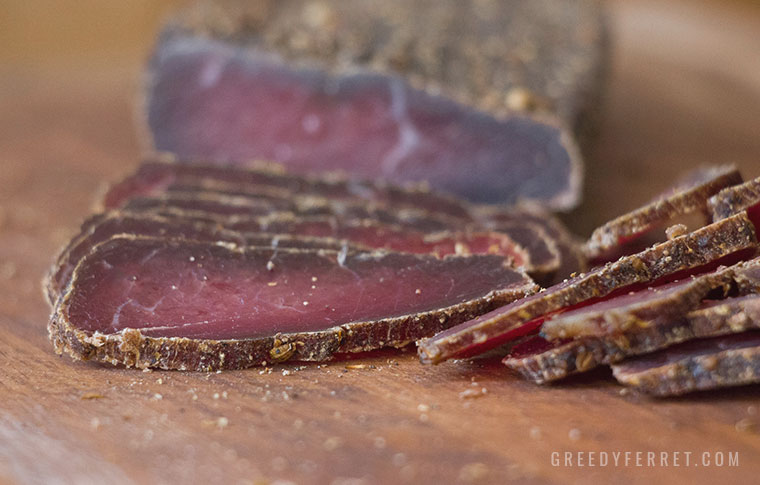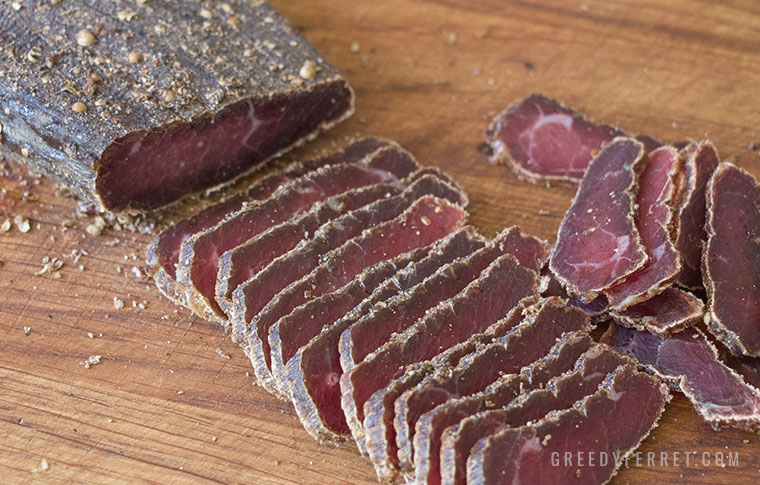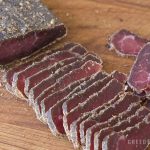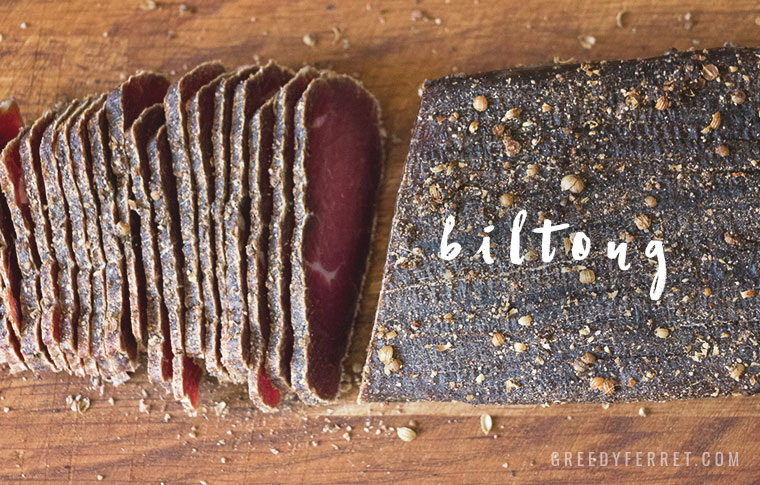I must apologise for calling biltong “South African beef jerky”, because this is a far superior product. If you’ve ever tried biltong, you’ll know exactly what I mean—none of that sugary, rubbery stuff-it-in-a-dehydrator rubbish here, please!
Like a lot of biltong lovers, I was introduced to this culinary treasure as a child, and the addiction has stuck. I’ve been making my own for a few years, gradually tweaking the recipe and feeding it to people with a “how is it, honestly?”, and plenty of willing feedback. I’m confident that this fool-hardy recipe sticks with the traditional roots of the dried meat, whilst adding a little refined finesse—it does not disappoint.
Biltong was originally created by Dutch pioneers in South Africa, “Voortrekkers”, who needed reliable food sources on their long treks across the continent. The method and spice mix hasn’t changed much in hundreds of years, but a few variations have appeared recently, like ‘piri piri’ biltong and the use of additional ingredients like worcestershire sauce and dried chillies.
Curing process
Opinions vary on curing methods, spice mixes and drying conditions, and there is a lot of misinformation around, so trial and error has been my friend. Some recipes call for several stages of curing and washing off spices, reapplying them, etc—this is not necessary. I don’t like to throw away good spices, so I coat once, leave to cure in the fridge, pat dry, then hang with no additional stages. Why wash off and waste all that good flavour? It’s easy to over-salt biltong, making it almost unbearable to eat in bigger quantities (let’s face it, who’s going to only eat a little biltong?), and too much salt can leave a burning sensation, so many recipes call for the salt to be washed off with a water/vinegar solution. My answer? Use less salt! Vinegar does a perfectly good job of sterilising the meat without mountains of salt. The salt is an excellent flavour enhancer and should definitely be included—just a little less to avoid the need for washing.
Temperature and airflow
What we’re trying to achieve when drying biltong is to concentrate the flavour of the beef by removing a lot of the moisture, similar to ‘dry aging’. A combination of good airflow and relatively cool temperatures are the key to successful biltong making. Contrary to popular belief, heat is not required to make biltong—neither does it make for a better product. As a perfect example of this, the Italians make a beautiful beef product called ‘Bresaola’, which is very slowly air dried at cold temperatures, so as to achieve an even dryness and texture. Although heat doesn’t add to the quality of the product, it can be used to increase air circulation around the meat, by means of a temperature gradient (heat rises!). Having said that, don’t be tempted to try and make it in the oven—biltong takes several days to dry, and most ovens won’t go low enough to dry the meat slowly enough to avoid cooking it. What you’re looking for is a slow drying process with gentle airflow. Many DIY biltong makers will use a ‘biltong box’ with a fan and a lightbulb in to create good air circulation. The key is to draw air around the meat without the airflow being too strong, to avoid ‘case hardening’, whereby the outside becomes overly tough, and the texture gradient falls off too quickly.
How to dry biltong
I made my first biltong by hanging it from a piece of wood jammed into a window frame beside a cool window, with a fan on low to circulate air. That’s really all you need to make it. If you want a little more control, you can upgrade to a biltong box or other drying box. I’ve since upgraded to an old fridge with the mechanics removed, holes in the bottom, and a fan drawing air past the meat. The airflow is just enough to draw away moisture, but not too fast so as to avoid over drying the outside of the meat. What you’re looking for is cool conditions with good airflow. Room temperature in most houses is fine, but air flow can be a problem. What you want is a good steady stream of air running past the meat, but not too strong. Try to create these conditions in whatever way you see fit. Just make sure you have a little air flow, or the meat can gather mould—I’m sorry to say this has happened to me in the past! If you want to have complete control over drying conditions, either making or buying a ‘biltong box’ might be the best option for you. You can pick them up pretty cheap online.
Doneness—How long does it take to dry?
I like my biltong a little tough, but still wet in the middle. Some like theirs tough like old leather. Getting it right is down to trial and error. The easiest way to measure dryness is with your fingers. Thoroughly wash and dry your hands, and squeeze the flattest sides of the meat in with your fingers. If there is any give in the meat, there’s still moisture in the middle. Most likely, what you’re looking for is a really tough consistency with just a little bit of give. Leave it too long and you’ll have some tooth-bustingly tough biltong on your hands. That said, it’s fairly forgiving and a day or two over won’t do too much harm.

If you’re impatient and can’t wait for your biltong to dry, plan ahead and cut some thinner pieces to hang with the rest—these will keep you going while you wait for the thicker stuff to be ready. If you’re really savvy, you might vary the thickness of slices from thin to thick allow for consistent grazing over the drying process (highly recommended).
If you find that you’ve cut your biltong early and it’s wetter than you’d like, use clean fingers to rub a little salt and vinegar on the exposed end and hang it back up.
Fat on or fat off?
This comes down to personal preference. It’s important to note that, while your biltong will shrink by around half the size when dried, the fat doesn’t shrink at the same rate as the muscle. I like a little fat because it helps carry flavour, but I tend to remove most of it before hanging. Large chunks of fat can be a little unpleasant to deal with when eating biltong.
Biltong ingredients
Every biltong maker has their own preference on spice mix. If you don’t know what you like, I suggest making a few thinner, quick drying pieces to experiment with. Many home biltong makers add a lot of ingredients to their biltong, thinking that adding more will lead to a better result, but in reality they’re muddying the clarity of the flavour and masking the star of the show—good quality meat!
Vinegar
Traditionally, brown vinegar has been used to make biltong. It really has a recognisable flavour. Some recipes call for balsamic or cider vinegar. I recommend brown vinegar for the best flavour, with cider vinegar coming in a close second. I’ve used cider vinegar a lot, purely because I have a large batch I made at home.
Salt
Salt is a brilliant flavour enhancer and preservative. It kills bacteria on the outside of the meat, and helps to draw moisture out. It’s tricky to get the salt quantity right. My recipe uses the smallest amount of salt required to make a safe cure, based on the weight of the meat. My local butcher goes way overboard with salt on their biltong. I sometimes use them in case of emergency biltong shortage, so I’m not sure how to break it to them…
Coriander
Coriander seed is the signature spice that makes biltong instantly recognisable. It’s best to toast the seeds to release the oils for flavour, but also because the oil suppresses bacterial growth.
Black pepper
Black pepper and beef are a pair made in heaven. Just don’t overdo it—biting into a lump of peppercorn is not a pleasant experience! You want roughly 1/4 pepper to 3/4 coriander seed for a good balance. In most cases, flies aren’t a problem, but pepper has the added benefit of detering them.
Brown sugar
Brown sugar has a caramel and molasses flavour that adds complexity to the meat, without masking it. The sugar helps with drying through osmosis, latching onto the water molecules and ‘wicking’ them away. It’s not a traditional ingredient if we’re going full purist, but it balances the saltiness well. Too much sugar is really unpleasant though—you’re walking dangerously close to beef jerky territory and I’d really recommend against it. Biltong is a savoury snack, not a desert!
Bicarbonate of soda
Some recipes call for the addition of bicarbonate of soda. This might seem a little odd, but it has scientific reasoning. The bicarb neutralises the acid in the vinegar, but also acts as a meat tenderiser. It slows the contraction of the proteins, leaving the final product still dry, but less tough. Bicarb has a pretty unpleasant taste, so it’s important to keep the quantity low. If you’re using a good cut like silverside or toprump, you won’t need it at all.
Cutting methods

If you’ve ever tried cutting over-dried biltong, you’ll know how tough it can be—tough as old boots! In desperation, I’ve taken to resting a knife on top of some over-dried biltong and hitting it with a camping mallet (not recommended, and not only because I upset the neighbours and smashed the chopping board!). There are a lot of creative, almost ceremonial devices on cutting biltong, but I think nothing beats a good, sharp knife. If you want something a little more fancy, there are biltong cutters (a board with a hinged knife attached), biltong knives (traditional knives made for purpose), hand crank mechanical cutters, and at the high end, expensive elecric cutters, mostly used by butchers and biltong suppliers.
Dealing with mould
Check your biltong every day for mould. If conditions are particulary humid or hot, there’s a chance you might experience this problem. If you see the first signs of mould appearing—white dots or furry mould—use a clean cloth with some vinegar and dab/wipe it off. Be sure to get it all or it’s likely to spread again. If you’ve not checked for a while and found your biltong totally covered, sadly the best place for it is the bin. Good airflow will help to avoid such catastrophes in future.
Storing your Biltong
After your biltong has dried to your preferred consistency, you can continue to store it hanging in a well aerated space indefinitely. Shops that sell biltong will often hang it and leave it out, and these are ample storage conditions—just try to make sure none of the pieces are touching. It will continue to dry slowly, but it will also keep for a long time this way. If you’ve cut your biltong and want to store it, wrap it in a few paper bags and store it in the fridge. The paper will allow excess moisture to continue leaving the meat, discouraging mould growth. I can’t give accurate advice on how long to store it this way, but I think it’s safe to say that no sane person is going to leave biltong uneaten for more than a few days. It’s just too delicious!
Case hardening
If there is too much air flow around your biltong, the outside can firm up really quickly, leaving the middle soft. If the case hardening is severe, the tough outer layer can prevent moisture from leaving the middle. If you find that you’ve been testing your biltong for readiness for 2-3 weeks and it just doesn’t seem to be drying in the middle, this may be your problem. If you suspect that case hardening is your problem, I recommend cutting through the end of the meat and checking it. If you’ve got a really raw centre and thick, tough outer surface, give it a try and see if you like the texture. If you don’t, the first option is to vacuum pack the biltong and store it in the fridge for one week to one month, depending on severity. This will balance out the gradient. If you don’t have access to a vacuum sealer, stick your biltong in a paper bag and place it in the fridge for a few days. Rub a little salt on the cut ends to protect them. This should go some way towards fixing the problem. It’s worth noting that the thicker you cut your initial beef cuts, the slower the drying process must be to avoid case hardening, so try cutting thinner next time. However, the best solution to prevent case hardening from occurring is to change your drying setup to reduce air flow. You still need a little air movement, but the slower it dries, the more even the moisture gradient will be from inside to out.
So without further ado, here’s my tried and tested biltong recipe. Once you’ve given it a try, please let me know how you like it, and if there are any variations to the traditional ingredients you swear by, no matter how strange!
Oh, I also added an extra function to the recipe that allows you to change quantities based on meat weight – don’t say I don’t spoil you! 😉

Perfect Biltong Recipe
Ingredients
Meat
- 2000 g Beef—silverside or toprump
Curing spice mix
- 5 Tbsp Brown (malt) or cider vinegar
- 2.5 Tbsp Coarse salt (2% of the meat weight)
- 2 tsp Ground black pepper
- 2 Tbsp Coriander seed
- 1.5 Tbsp Brown sugar (optional)
Instructions
- Toast the coriander seeds in a dry pan, then grind down in a pestle and mortar or spice grinder. It should be mostly powder, with a few pieces of seed shells left in.
- Using a sharp knife, following the grain of the meat, cut into 1 inch (2.5cm) thick lengths and place in a non-metallic container.
- Combine all the spices and sprinkle into the meat. Sprinkle the vinegar on and rub everything in thoroughly whilst turning the meat with your hands.
- Cover the container and let your biltong cure for 24 hours in the fridge, turning and rubbing through the meat occasionally.
- Remove the meat from the container and pat dry with kitchen towels, taking care not to remove too much of the spice.
- Add a hook to the thickest end of each length. Plastic-covered paper clips make for a cheap solution. Hang in your biltong box, or in a well aired, ventilated space with a fan blowing gently to increase air flow. Do not point a fan directly at the meat (to avoid case hardening). Make sure none of the pieces are touching. Place some newspaper below the meat to catch any liquid.
- Drying times will vary with humidity, airflow and temperature. Test the readiness of your biltong every couple of days by squeezing the sides together with clean fingers. If you feel any give in the meat, it’s still ‘wet’ inside.
- Once ready, cut into thin slices with a sharp knife and enjoy some of the best meat you’ll ever eat.


Thank you for these helpful and wise words on the art of biltong-making! I lived for 2 years in Zimbabwe with my family when I was a teenager, and ever since I’ve missed this devine snack.
So 15 years later, a few years ago I had my cabinet-maker friend make me a beautiful biltong cabinet from Danish pear wood (with a small fan from a laptop built in, with adjustable speed, -this works perfectly!), brass bars for hanging, and now I’m regularly making biltong, serving it to my friends who get very excited over how much better than beef jerky it is, and to my family who also missed it ever since Zims.
So just to let you know that there is a biltong ambassador in Copenhagen! I use the same spice combination as you do, using malt vinegar and maybe a bit more coriander. Sometimes adding a bit of cayenne pepper for a spicy version.
I’ll try to post some pics of the biltong cabinet if possible.
Best wishes, Frey
Is there a preferred temp to hang the meat at.? Also how about humidity as well.
I built my own biltong box before Christmas and have already had successful results thanks to you and this page.
I was just wondering, what is the optimum temperature range? Do I need a bulb if the location of my box is around 18-20c? Will the fan suffice? Thanks.
Just tried this recipe and the results are A1!!
Hi! Is the vinegar used for flavor or to help fight off bacteria? I ask because I used baking soda as recommended (for venison), and it reacted to the vinegar, which is expected. However, this made me think…isn’t the baking soda neutralizing the acid in the vinegar? Does this counteract the purpose of the vinegar? Thank you!
I use angostura bitters and worschteshire in my initial marinade 24-48 hours. Then pat the meat dry and season with cinnamon (not too much a little goes a long way), cayenne pepper, celery salt about 2tsp for 2lbs of meat, corriander, fresh finely ground peppercorn (ground with mortar and pestle), himalayan pink salt fine grind just a little extra salt to make sure I get a good cure (like how I would season a steak that’s already been cooked kind of? Best as I can explain, sorry been cooking for a while and just know salty like too salty and how I like salty), then I use Filipino brown vinegar (and no I’m not Filipino) which is made from brown sugar like the really dark molassesy stuff that I have mixed with some you guessed it: himilayan pink salt in a spray bottle for spritzing intially and if any “freshening up” is required. The real key flavors that really pack a punch leaving you like wtf was that?! In a really good way is the angostura bitters and the worsteshire and oh how I wish I could concentrate more of that flavor to just the right into the cent of the meat. Everything else is just a compliment to those flavors and aromas created from the marinade 🤤 try it or don’t idc I like what I’ve done. More or less probably leaving some steps out but you get the idea.
I built my own biltong box and followed your spice mix recipe to the letter. Will comment again when I’ve had my first taste.
(So far, so good)….
I’d love to try this soon, I’m tired of spending a small fortune on Cruga every week. I was just wondering about the possibility of wet brining. I’m brining a couple of briskets at the moment for making salt beef – I use a pretty strong 10% salt and sugar solution with pickling spices and 15g of Prague Powder No.1. I brine 3 kgs for 7-10 days and usually desalinate the briskets for a few hours in water before cooking and they make nice salt beef. I was wondering if I could perhaps cure a silverside joint the same way for biltong? Maybe a 5% brine, smaller amount of sugar and a smidge of Prague Powder? I’m not sure if I’d need PP No. 2 for biltong. Then I was thinking I could remove the meat from the brine,desalinate for a few hours, pat dry, slice up, apply spice rub and leave overnight before starting to dry it. Worth a try or overcomplicating the process? My thinking is it might help with preserving the meat a little better?
Just made my first batch of bio tong,your recipe is excellent !
Sliced very thin .
It has that perfect beef flavour,very rich and beefy.
Goes very well with Macallan Scotch.
Now I know what South Africans rave about.
Thank You.
KGL
Dear Sir,All,
Greetings from Ethiopia. Thanks for the article. I wanted to ask for your expert view. I do biltong production for the market, I imported the drying cabinet from South Africa. My challenge was, I wanted to get as much weight from the produced Biltong while giving it sufficient shelf life (150 days and above). Can you recommend the number of days it should hang and save at least half of the meat’s weight?
best,
Samuel
My name is Rich Miner, and I am the host of a new cooking and travel channel on youtube -The Iberian Cooking Channel. From my many years of living in Spain, cooking Spanish, Portuguese, Italian and Greek foods, as well as elaborating similar products to Biltong and having worked in the commercial Foods insustry, I must say it’s uncanny that BILTONG is very similar to Spain’s Leon Province “CECINA”
(pronounced theh – theena..In this case the Spanish “c” is like “th” in the word thimble.)
I imagine that Biltong and other similarly cured meats have been developed in many cultures around the world lost to time.
In the case of the Beef CECINA of Leon-Spain, surprisingly, it has its origins with Romans in the same area of Leon, Spain.
Reference to Cecina was mentioned in agricultural writings of Lucius Junius Moderatus Columella, (born 1st century A.D, Roman city Gades, Hispania) a Roman soldier, farmer, and author. It’s a shame that not many such traditions such Biltong or Cecina haven’t survived into the 21st and some are being rediscovered. I have attached a photo of Cecina from a producer’s website for comparison. If any of you are interested in learning more about Spanish and Portuguese Foods, recipes, Wines/Spirits and travel please come to my new channel inaugurating the 10th of December, 2020.
Cheers!
I watched an episode of chopped take over and Alton Brown made beef jerky using a boxed fan and square air filters on the show. It was neat, I was like what. So I guess to make biltong, is a similar process too.Thank you for sharing!
Hi! What’s the difference if I first just use just the vinegar to soak the meat and then, the day after, put the spices on the meat before hanging it?
Thanks 🙂
First attempt at biltong was after short (drunken) phone instructions from a Yarpie sailing mate, using my stainless steel hot-smoking cabinet. Result was shoe leather covered in white mould and tasting of mackerel …..
Greedy Ferret’s method using local Guernsey beef silverside in a dryer made from an old kid’s toybox has produced an amazing product. Four days at 22 degrees C with a PC fan / light bulb arrangement, well ventilated. I upped the crushed coriander and pepper as we like it spicy but otherwise just followed the recipe. Perfect. Thanks indeed! Next batch will be French wild boar.